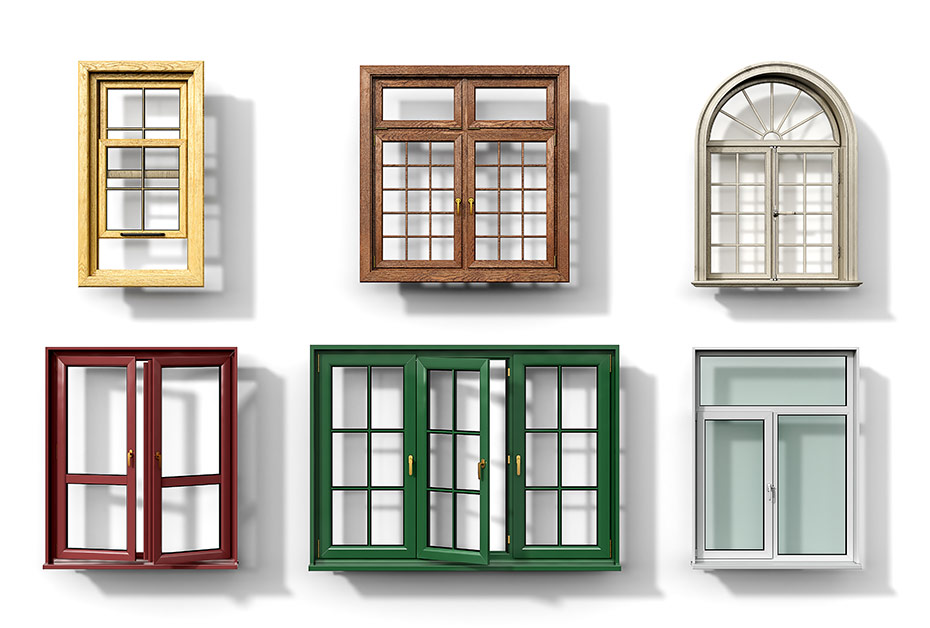New windows bring a welcome flood of natural light to beautify any home. Ordering the windows you really want, however, can be confusing. You’ll often face a wall of technical window terminology and jargon when planning to remodel or replace your home’s windows.
Today, we’re here to help with a handy window term glossary! Use our window dictionary to help decode obscure window lingo, and get the perfect “mullions” and “R-value” for windows in each room of your house.
Window Parts Glossary
HEADER
Horizontal component forming the top of the window frame.
JAMB
Vertical sides of the window frame.
CASING or CASEMENT
Also called the trim or molding, casing surrounds the window, between the wall and jambs.
SASH
The frame for the window glass or panes. On double-hung windows, two window sashes slide up or down inside of the jambs, and come together to close the window (at the rail).
SASH LOCK
A window lock or latch for security.
RAIL
The top or bottom horizontal part of the window’s sash.
SILL
Horizontal bottom part of the window frame, which the lower sash contacts when the window is closed.
FRAME
The outside edge or perimeter of the window, which attaches the window unit to the wall opening. The frame includes the jambs, head, and sill.
PANE
The glass sections of a window.
MULLIONS or a WINDOW GRILLE
Decorative detail that economically adds the look of multiple panes, visually dividing a larger single pane of glass, into sections or a grid.
BALANCE
Hidden window part inside the frame of a double-hung window, which helps balance the window sash’s weight as you open (raise) or close (lower) it.
STOOL
The part of the windowsill running from the lower sash rail and extending slightly into the home.
APRON
Decorative trim running under the stool against a wall.
SPACER
Today, most windows are made using multiple glass panes with an airtight space between them. The actual spacer substance is typically a vapor that insulates your home for energy efficiency while preserving your ideal view.
KRYPTON or ARGON GAS
Clear, inert, and non-toxic spacers filling the space between layers of panes, used to insulate windows for energy efficiency. The gas displaces/replaces trapped air between the double or triple panes.
IGU (Insulating Glass Unit)
Window glass panes with the spacer between, vacuum-sealed, and considered a single unit. Also called a double-glazed or double-pane window.
WEATHER STRIPPING
Covers any small spaces around the window, to keep rainwater and exterior air out. This prevents damage to your windows and home, increasing home energy efficiency.

Window Glass Terminology
LOW-E GLASS
This energy-efficient window glass is coated to insulate your home, minimizing infrared light and UV rays that pass through, without darkening your room. Low-Emittance windows glass helps protect furniture from fading while keeping the indoors comfortable.
TEMPERED GLASS
Heat-treated glass, then rapidly cooled and compressed to meet safety requirements, making it much harder than regular glass. If broken, tempered glass breaks into many small cube-shaped pieces, rather than sharp glass shards like untreated, regular glass.
ETCHED GLASS
Beveled or textured, decorative glass that offers privacy while still allowing light in.
TINTED GLASS
Another decorative option that also provides privacy.
Window Performance Rating Terminology
R-VALUE
This window terminology describes the amount of insulation provided by the (typically double- or triple-pane) windows. Higher numbers mean better heat-resistance for your home, so higher R-values better limit heat flow from outdoors to inside (or vice versa) depending upon the season.
U-FACTOR
Heat loss rate expected from your window, based on its materials and construction. In this case, lower is better. (Ratings listed on products can be skewed, so be sure to consult your window installation pro for advice).
SOLAR HEAT GAIN COEFFICIENT
The SHGC is the percentage of solar radiant energy that can penetrate a window, normally shown to be a decimal between 0 and 1. A lower SHGC means more shading provided and less solar heat transmitted through the window.
AIR LEAKAGE RATING
Calculated to show you how many cubic feet of air can penetrate a window per minute, divided by your total window area. The smaller the number, the more energy-efficient that window will be. Ratings under 0.3 are considered energy efficient by ENERGY STAR.
VT (Visible Transmittance) RATING
Higher VT means more visible light is coming through the window, which can help you reduce glare into your home while maintaining the ideal amount of natural daylight you want and need.
LSG (Light-to-Solar Gain) RATIO
A higher LSG number, calculated as the ratio between SHGC and VT, gauges the “light transmission efficiency” of your window. It is a relative measure to compare how well your window lets light in, without heat gain (without transmitting unnecessary heat into the home).
Avoid Window Confusion and Get Perfect New Windows
Planning to add or replace windows for essential natural lighting in your home? Need more in-depth information about new window options for your remodel? Cut through the window terminology and jargon with personalized advice from the friendly experts at AAA Windows 4 Less. Contact us today.
